Gerda Wegener
Gerda Wegener was a Danish artist famous for her fashion illustrations and paintings, carried out in the styles of Art Nouveau and later Art Deco, that pushed the boundaries of her time concerning gender, sexuality and love. Her works, many of them inspired by her partner Lili Elbe, (née Einar Wegener, 1882 – 1931, Danish painter, transgender woman and one of the earliest recipients of gender-affirming surgery) were classified as lesbian erotica or, even, pornography.
At an early age Wegener moved to Copenhagen to pursue her education at Det Kongelige Danske Kunstakademi (the Royal Danish Academy of Fine Arts), graduating in 1907. Wegener then made a career for herself working as an illustrator after winning two sketching competitions in the Politiken newspaper (once in 1908 for capturing ‘Copenhagen Women’ and, again, in 1909 for drawing ‘The figures of the Street’). Wegener was now becoming known for her stylish illustrations created for advertisements whilst also working as a portrait painter in the elegant and decadent style of the early 1910s.
During her years at the academy she met fellow artist Lili Elbe – then known as Einar Wegener – at school. They subsequently married in 1904, when Gerda was 18 and Einar/Lili was 22. The married couple travelled through Italy and France, eventually ending up in Paris (in 1912) where they immersed themselves in the Bohemian lifestyle of the time, befriending many artists, dancers and other cultural figuresfrom the artistic world. After settling in Paris Wegeners husband Einar began to wear female clothing, adopting a female name and persona. Einar/Lili would now become Gerda’s favourite model, in paintings of beautiful women with haunting almond-shaped eyes dressed in chic fashions. This led to a minor scandal in 1913, when a shocked art world learned that the model who had served as inspiration for Wegener’s depictions of desirable petite femmes fatales was in fact her ‘husband’.
It wasn’t just Einar/Lili that transformed radically in Paris. Gerda also began to push the boundaries in her artwork by creating more provocative paintings of women engaged in sexual activities and seductive positions. She often painted herself with Lili (or Lili alone, either portrayed as a man or a woman). Her daring art caught the attention of the Paris avant-garde and her work in the fashion industry took off, at the same time, as she illustrated for magazines such as Fantasio, Vogue and La Vie Parisienne. Her illustrations were used in a wide range of platforms from beauty advertisements to political anti-German images in the Le Matin and the La Baïonnette during World War II. Wegener’s traditional easel painting also continued to be met with recognition, earning her two gold medals and a bronze one at the legendary 1925 Exposition internationale des arts décoratifs et industriels modernes (World’s Fair) in Paris. Furthermore she was exhibited in the Salon des Humoristes, the Salon des Indépendants andthe Salon d’Automne.
As Elbe adopted her female identity, Gerda Wegener commonly introduced her as Einar Wegener’s cousin (when dressed in female attire). In 1930 Elbe underwent one of the first sex reassignment surgeries. As Danish law at the time did not recognize marriage between two women, their marriage was annulled in October 1930 by King Christian X (1870 - 1947). Elbe later died, aged 48, in 1931 from complications relating to her fourth, and final, sex reassignment surgery, which took place in Dresden, Weimar Republic.
In 1931, Wegener married Italian officer, aviator and diplomat Major Fernando Porta and moved with him to Morocco. She divorced him in 1936 and returned, for unknown reasons, to Denmark in 1938. Wegener held her last exhibition in 1939, but by this time her elegant and decadentArt Deco style was deemed a thing of the past as the Functionalist movement (embracing Purism and Concrete Art) had become more popular in the 1930s. She had no children, lived by herself in relative obscurity, and began to drink heavily. She faced financial instability and kept an income by selling hand-painted postcards. Gerda Wegener died, in Frederiksberg, Denmark on 28 July 1940, shortly after Nazi Germany invaded invaded the country. Her small estate was auctioned and there was only a small obituary printed in the local paper.
